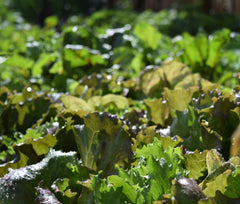Gearing up for Fall & Winter Gardening
Posted July 30, 2013

It's hard to think about fall gardening when temperatures are raging in the triple digits, but mid-July and August is the time to start seedlings and prep your soil for a great fall and winter garden. Prep your garden beds just as you would in the spring. Spring and Summer veggies have used up many of the nutrients you added early spring. A nice lush layer of compost dug or tilled into beds is a must! Depending on what you are planting, your soil may need a boost of organic fertilizer. Leafy crops will benefit greatly from a feeding of a high nitrogen fertilizer such as blood meal or feather meal. Work this into the top 1-2" of the soil. For root crops, phosphorous and potash will provide nutrients for nice healthy root systems.
We
Turnips are milder and more tender when grown in the fall. Sow seeds every two weeks in smaller bunches for continued harvest. Young turnip greens are great in salads and in stir fries. Light fall frost will "sweeten" turnips.
Brassica crops (kale, , cabbage, ect) should be started from seed mid-July to mid-August depending on your first frost date. When using transplants take extra care. Hot sun rays will quickly burn up new tender starts. Plant out on cloudy days, late evening or use floating row cover to prevent sun-scald. For bigger heads on broccoli, cauliflower and cabbage, add mycorrhizal fungi and bio-fish organic fertilizer in transplant hole when planting. Brassica crops like to be firmed into prepared soil when transplanting. Lightly press on the soil around the base of the transplant and give a slight tug on a leaf. If the transplant pulls out, it needs to be firmed in more, if the leave tears slightly, it's in it home secure, ready to produce. Brussels Sprouts are the tastiest and have the least bug problems when planted in September in our zone 8, kept covered with a light frost cover until harvest time in late February. Can you imagine...fresh veggies from the garden in February!
Radishes are fabulous when grown in the fall. China Rose Radish is very large and is even better once touched by frost. In mild climates it can overwinter. China Rose Radish adds a nice crunch to vegetarian pizza, salads and sandwiches.
Onions can be planted for early spring harvest in the fall for mild winter zones. If your temperatures drop down into the teens during the winter, a covering of mulch or straw is very important to keep onion plants from heaving up, which causes severe damage. In colder regions, onions should be planted in the spring.
Carrots need to be started towards the end of July so they can get a sturdy root system. Once the cold weather hits, carrots sweeten and can be stored in their built in "garden root cellar" with a little mulch to protect from hard freezes. Carrots seeds should be extremely fresh for good germination and never allowed to dry out after sowing seed.
Grow your own greens all winter long by using cloches or cold-frames. When using cloches and cold-frames you can protect lettuce, spinach and other crops during the coldest winters. Planting lettuce and spinach in cold-frames can be done as early as September, and continued all through winter in most zones. Beets and Swiss Chard will give exceptional greens during the winter months in cold frames. Do not over crowd when such growing is done. If winters drop into single digits, you can cover cloches and cold frames with a frost blankets or a quilt to keep the coldest of temperatures from deep freezing crops. If you have never grown in a cold frame, you are truly missing out on many winter growing opportunities.



Comments (0 Comments)
There are no comments.
Post Comment